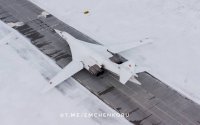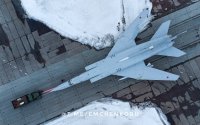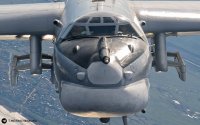Essentially, France can afford the indulgence of a single "vanity" carrier to "maintain competency" and pretend that it is still a great power. Russia cannot afford this.
France has a single "necessity" carrier because it can afford only one carrier but can't afford none. It allows France to project limited but sovereign power with regards to Guyana and Africa. Single ship limits availability but France's strategic interests are not threatened by unpredictable and random events due to France's constant political involvement in those regions so they can prepare in advance and plan for alternatives, because their focus is much more limited than Britain's.
Britain has "tribute" carriers augmenting US power projection in exchange for minor share of the spoils which feeds the mining and banking corporations on London Stock Exchange. This economic interest is the real reason for Britain's continuing alignment with US military adventurism - compare with Australia, Canada and New Zealand. Britain needs two carriers because it must react at similar timescales as the US does and because US has global involvement with eleven carriers and eight LHDs Britain needs to be ready at any time. Royal Navy's fleet structure reflects that directly. Britain's logistical capability is determined by time constraints imposed by American power projection capability.
Russia has a "vanity" carrier because it has no strategic need for carriers and the problems which can be optionally solved by a carrier, can be solved by other means more efficiently. It maintains a carrier because it is an industrial special interest, much more than a political status symbol. If Russia loses its only carrier then an entire area of military production becomes theoretical, and in this market it means nonexistent. Without Kuznetsov there is no MiG-29K and without it there's no entry into Indian naval aviation and additional funding for Mikoyan etc.
The influence of Russian defense industry on procurement choices is greatly overlooked. Russian MIC is second only to American MIC in terms of its economic and political influence. The entire modernization of aviation in recent decade has been driven by special interest and economic policy and not by rational choices.
Russian strategic planning and procurement is so inefficient because of nukes. Without so many nukes Russia would have to rationalize ruthlessly and painfully. But with nukes it can afford to put itself into strategic equivalent of heroin addiction.
A great example that illustrates this:
you get much better picture from factory where these things are continously modernized.
When in 1992 Yeltsin made the (correct) decision to shut down production of Tu-160 Russia had only
seven Tu-160s, with twice as many left in Ukraine in Pryluky air base. Ukraine had no means of supporting the bombers but refused to give them up until 1999 when in consequence of the Russian financial crisis economic situation of Ukraine became even worse than Russia's and gas debt was used as leverage.
Eight Tu-160s were sold, rest was unserviceable or was scrapped.
Why Russia wanted Tu-160s? Because
at the time Tu-160 and Kh-55 were the most modern tools of air power in Russian arsenal and Kremlin thought it needed it to respond to American air interventions like in Serbia. The alternative was Tu-95MS before modernization and Tu-22M3 with insufficient range and payload.
An important but forgotten factor is the political climate of the 1990s and the peace dividend that majority of political establishment in America supported. That was the context of that decision. Washington's reaction to 9/11 should have changed Russia's entire strategy but that would require pragmatic thinking, and that would require recognizing a permanent loss of status - something Moscow was (and is still) unwilling to accept with tragic consequences. Psychologically it's always easier to grow than to shrink.
Correct response would be to abandon plans to restart Tu-160 production, focus on deep modernization of Tu-95 fleet and start developing a flying wing design by practical means i.e. starting with a single-engine drone like the nEUROn first demonstrated in 2005.
Sub-sonic flying wing is the necessity for penetrating bombers. A bomber which is not a penetrating aircraft is by definition a stand-off bomber. Stand-off bomber is defined by its economy - this is why USAF retires B-1B (stand-off) and modernizes B-52H (stand-off) and introduces B-21 (penetrating) and tests palletized stand-off munitions. Non-VLO penetrating bombers were targets in 1980s and
Russia knows it because it was MiG-31 that made it so!
Tu-160M2 is so unviable that Tu-22M3 had to be included to pay for NK-32-02 variant, even though Tu-22M3M is even more obsolete and uneconomical than Tu-160M2 and Ch-47M2 won't change it.
VGA/FGA - variable/fixed geometry airframe
now:
- 16x Tu-160: 16 VGA + 64 NK-32
- 60x Tu-22M3: 60 VGA + 120 NK-25
plan:
- 27x Tu-160M2: 27 VGA + 108 NK-32-02
- 30x Tu-22M3M: 30 VGA + 60 NK-32-02
Bear:
- 55x Tu-95MS: 55 FGA + 220 NK-12
- 22x Tu-142: 22 FGA + 88 NK-12
Tu-95MS carries 6 Kh-55 internally and 8 Kh-101 externally. Tu-160 carries 12 Kh-101 internally. Speed difference is not relevant.
Deep modernization of Tu-95, similar to Tu-160M2, would provide a continually available fleet of long-range bombers of at least 60 aircraft, but likely more. In 1991 Tu-95/142 (all variants) fleet consisted of over 200 airframes. Considering Russia's geography economic stand-off bombers are so important that it wouldn't be irrational to partly restart Tu-95 production to fill the gap before flying wing design becomes available.
Moreover Tu-95 is powered by four NK-12 engines, each producing 11 000 kW of power. Tu-95MS has a MTOW of 188t and total power of 44 000 kW (4,27 t/kW ) Comparably EC-130H Compass Call - an USAF electronic attack aircraft - has MTOW of 80t and total power of 14 000 kW ( 5,71 t/kW) which indicates that modernized Tu-95, especially with weight reduction, could be a viable interim platform for electronic warfare and
Tu-95 were used in that role before 1991.
Focusing on cheap Tu-95 and viable PAK-DA would be good for long-term strategy but bad for failing industry, and failing image of a self-styled superpower. Compare:
- US is flying B-52 until it has enough B-21s and retires obsolete B-1s as soon as it can justify not spending money on them.
- China is flying H-6 until it has enough H-20 and said no to Tu-22/Tu-160/B-1 because it's obsolete concept.
- Russia is flying Tu-95 until it has enough obsolete bombers because in Russia obsolete bombers are the future.
timeline of Tu-160:
- 1981 (-3) - first flight
- 1984 (+0) - production start
- 1987 (+3) - introduction
- 1992 (+8) - production end after ~24 built
- 1999 (+15) - new order for (one) Tu-160
- 2002 (+18) - order for modernization of 15 active bombers
- 2003 (+19) - new engine test airframe crashes
- 2005 (+21) - Putin flies in Tu-160 to secure funding
- 2006 (+22) - first new Tu-160 delivered
- 2007 (+23) - second new Tu-160
- 2017 (+33) - third new Tu-160
- 2023 (+38) - first delivery in ongoing order for 10 new and 17 modernized Tu-160M2s
This story doesn't have a happy end.





